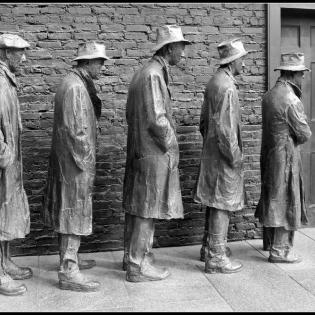Solutions to The Great Depression
Participants discuss and analyze the solutions implemented by President Roosevelt during the Great Depression. The role that philanthropy played in helping to end the Great Depression will be central to the discussion.
Participants will:
- describe how the New Deal components affected all segments of society.
- evaluate the role of nonprofits during the New Deal.
- explain how philanthropy created community capital during the Great Depression.
- YouTube: How FDR’s New Deal Put America Back to Work During the Great Depression
- New Deal Legislation handout below
- The Great Depression Chart Government & Nonprofit Activities
- Fugate, Sandy. For the Benefit of All. Battle Creek: W. K. Kellogg Foundation, 1997. ISBN: 1-891445-00-6
- Guidestar http://www.guidestar.org
Instructions
Anticipatory Set:
Discuss what President Roosevelt should have done to solve the problems of the Great Depression. Show the video "How FDR's New Deal Put America Back to Work." See link above.
Distribute copies of the handout New Deal Legislation below or linked here. Discuss the following:
- Compare the New Deal program divisions to the solutions categories from the previous lesson.
- Reflect on the interview stories from lesson one, and discuss how people from those stories might have been affected by the programs created by the New Deal.
- Notice the starting dates of the New Deal Programs. Talk about why developing these programs during The Great Depression was a slow process.
- How did nonprofits and families help people and the nation survive before all the programs were implemented?
Define community capital as the good will developed between people and organizations because of positive interactions that carries over to new situations in the community. Discuss how community capital was built up during the Great Depression. What are examples of community capital in present day? How can we invest in community to build capital (like saving in a bank account for hard times in the future)?
Many nonprofit organizations began during the Great Depression to help address the needs of the time. Review the handout The Great Depression Chart of Government and Nonprofit organizations (see handout below and linked here) and compare the philanthropy of the government with the philanthropy of the nonprofit sector. Which of these nonprofits are familiar? Youth can work in groups to look up a nonprofit and identify its mission today.
Service Component: Reflect on the missions of the foundations you researched. What issue are you passionate about? Contact a local nonprofit that addresses that issue to ask about their needs and how you can help.
Philanthropy Framework
-
Strand PHIL.I Definitions of Philanthropy
-
Standard DP 02. Roles of Government, Business, and Philanthropy
-
Benchmark HS.1 Explain why needs are met in different ways by government, business, civil society and family.
-
Benchmark HS.2 Provide examples from history of how the relationship between government and the civil society sector has changed.
-
Benchmark HS.3 Identify an example of failure in each sector, and how the other sectors modified their roles in response.
-
-
Standard DP 05. Role of Foundations
-
Benchmark HS.1 Define the term foundation and describe the types of foundations.
-
-
-
Strand PHIL.II Philanthropy and Civil Society
-
Standard PCS 03. Philanthropy and Economics
-
Benchmark HS.4 Give examples of how civil society sector giving by individuals and corporations can impact communities.
-
Benchmark HS.6 Explain how economic systems encourage or discourage philanthropy and the civil society sector.
-
-
Standard PCS 05. Philanthropy and Government
-
Benchmark HS.13 Define and offer examples of community/social capital.
-
-
